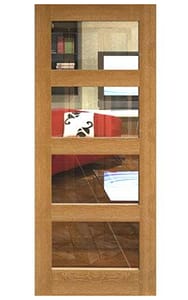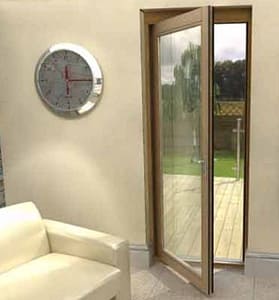Doors today come in many shapes, sizes, colours, and of course – materials. Steel, aluminium, fibreglass and uPVC are all familiar players in the field. The type of material you choose for your door will depend on several things, not least budget. As technology has advanced, and the door market has expanded to accommodate a range of customers, wooden doors still remain as popular as ever.
In short timber doors are ideal for both internal and external doors.
Unlike uPVC, composite, and aluminium doors, wooden doors are suitable as both internal doors and exterior doors. This is perfect for homes looking to keep their interior design in uniform with their exterior. Wooden exterior doors offer strength and security whilst wooden interior doors offer a high-end feel. Their finish can be altered as you wish, and if maintained correctly, can outlast most other types of door.
We’ll discuss the benefits in more detail shortly, but it’s worth noting that teaming internal and external wooden doors can help create a more consistent, integrated appearance throughout the home.

Before we get into the advantages and disadvantages of a wooden door, it’s helpful to explain that there are two main types of timber door available: solid wood and engineered wood.
Solid wood doors are made from a single piece of wood or several pieces of the same variety of wood. These are then glued together with particular joints to create a large, sturdy door leaf.
Engineered wood has an outer layer and an inner layer. The outer layer (or veneer) is made of a more expensive and attractive piece of wood while the inner layer is formed of a variety of woods to create a solid structure from the centre.
As they use a smaller quantity of high quality woods, engineered doors tend to be cheaper than solid wood doors – but which door is better?
On the outside, the aesthetic is very similar. As an engineered door can be veneered in a variety of woods, it can achieve almost any style for your home. Due to their advanced construction, engineered doors will not warp and can be more thermally efficient than solid wood doors. On the other hand, solid wood doors can be much simpler to repair. For more information read our article on choosing the right door for you.

One of the biggest benefits of a wooden front door is how great it looks. Its traditional style can provide much more curb appeal to your home than other materials. As a natural and extremely versatile building material, wooden doors come in a far wider range of designs than their uPVC, fibreglass or metal counterparts. The craftsmanship is clearly visible, which adds to the overall appeal. This appeal goes beyond looks. Wooden doors bring about a traditional feel to your home and are an excellent alternative to incite a sense of homeliness
Their versatility means they can be tailored (in size, style of wood, and design) specifically to your home and aesthetic. As no two pieces of wood are exactly the same, your wooden front door will be completely unique to you. The benefits of timber doors mean that whether you prefer light wood, dark wood, painted surfaces, tight grain, wide grain, simplicity or intricate design work, anything is possible.
One of the key benefits of wooden doors is external security. Wooden doors are incredibly strong, and developments in their design and construction over their hundreds of years of manufacture mean they can outlast some of their counterparts. They are one of the few door materials that can be repaired, as wood is malleable and easy to work with. This means a wooden door will offer you great security and reliability over its long life.
All of these things are important, but a wooden door benefits you in another way as well. Wood retains fantastic insulation properties, and with minimal maintenance, can improve your home’s thermal efficiency. The properties of the material mean that warmth is kept in, and noise is kept out more so than with most other types of door. As long as the wood comes from a sustainable source, it’s environmentally friendly, too.
There’s no doubt that the advantages greatly outweigh the disadvantages of wooden doors. this doesn’t mean that wooden doors come without their flaws, however.
The primary disadvantage of timber doors is their cost. They sit at the luxury end of the market, and as such command a higher price than doors made from cheaper materials. However, a hardwood door will need to be replaced less often, meaning you should end up spending less in the long term.
With a renewed focus on quality, efficiency, longevity and environmental care, wooden doors tick a lot of boxes when it comes to building a home that is safe, sensible, and on-trend. Whilst we can’t claim that there are no problems with a wooden door, there certainly aren’t many, and the advantages are plentiful.
Start shopping for wooden external doors here, and wooden internal doors here.
You’ll need to trim mm off the left & right of each door
You’ll need to pack mm either side of the frame
You’ll need to trim mm off the top and bottom of each door
You’ll need to pack mm above
You’ll need to trim mm off the left & right of each door
You’ll need to pack mm either side of the frame
You’ll need to trim mm off the top and bottom of each door
You’ll need to pack mm above
You’ll need to trim mm off the left & right of each door
You’ll need to pack mm either side of the frame
You’ll need to trim mm off the top and bottom of each door
You’ll need to pack mm above